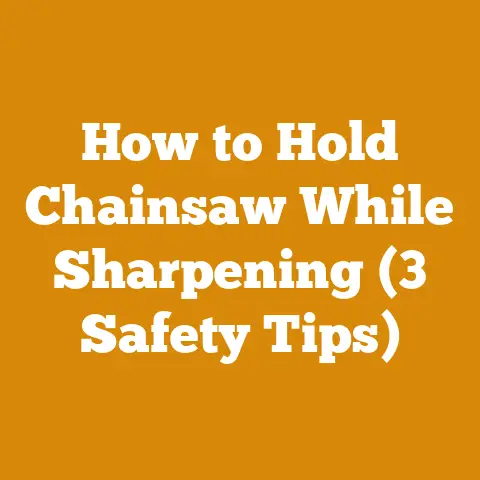what is a chainsaw blade (Types Explained)
Let’s chat about chainsaw blades.
Think of them as an investment not just in
your efficiency but also in your safety and
the quality of work you can achieve.
A good
blade can be your best friend when you’re out
in the yard tackling that overgrown tree or
taking on a new woodworking project.
My First Chainsaw Blade Experience
Let me take you back to when I first got my hands
on a chainsaw.
Like many of you, I was pumped to
start some serious cutting.
I had this big oak
tree that just needed to go.
With a chainsaw in
one hand and a cheap blade in the other, I thought
I was ready to roll.
But, oh boy, was I in for a
surprise!
The blade dulled fast, and every cut felt
like a battle.
That day, I learned not all blades are
created equal.
Types of Chainsaw Blades
Now, let’s dive into the different types of chainsaw
blades.
Each type has its strengths and weaknesses,
so understanding them will help you choose the right
one for your needs.
1. Full-Chisel Blades
These blades are the speed demons of the chainsaw world.
They have square-cornered teeth designed for maximum
cutting efficiency, especially in softwoods like pine
or spruce.
But here’s the catch: they can dull quickly
and aren’t ideal for dirty or frozen wood.
Pros: Fast cutting speed, excellent for softwoods.
Cons: Prone to dulling, not great for dirty wood.
Story Time: I remember the first time I used a
full-chisel blade.
I was working on some pine logs,
and it sliced through them like butter.
But when I
tried it on some old, dirty wood, it was a different
story—dulling in no time!
2. Semi-Chisel Blades
Semi-chisel blades are the versatile all-rounders.
With rounded-cornered teeth, they can handle hardwoods
and even slightly dirty wood better than full-chisel
blades.
Pros: Versatile, longer-lasting sharpness.
Cons: Slower than full-chisel blades.
Tip: If you’re working with mixed types of wood
or dealing with less-than-pristine conditions, these
are your go-to blades.
3. Low-Profile Blades
If you’re new to chainsaws or just want more control,
these blades are perfect.
They come with smaller teeth
and lower kickback potential, making them safer for the
less experienced.
Pros: Low kickback, safer for beginners.
Cons: Slower cutting speed.
Personal Insight: When teaching my kids about chainsaws,
I always start them off with low-profile blades.
It’s a great
way to get comfortable with the tool without too much risk.
4. Ripping Blades
For those who want to mill their own lumber, ripping blades
are essential.
They cut along the grain rather than across it,
ideal for making boards and planks.
Pros: Ideal for milling lumber.
Cons: Not suitable for standard cross-cutting.
Experience: My buddy once decided to mill his own barn wood.
He swears by ripping blades for getting those clean cuts along the grain.
Equipment Requirements
Before you jump into action with your chainsaw, make sure you have:
- A well-maintained chainsaw
- The appropriate blade for your task
- Safety gear (gloves, goggles, helmet)
- Chainsaw oil
- Chain file or sharpener
Prerequisite Knowledge
Understanding how your chainsaw operates is crucial. Make sure you:
- Know how to properly start and stop your chainsaw
- Understand tensioning and maintaining the chain
- Are familiar with safety protocols
Safety Callouts
- Always wear protective gear! Never skip on gloves, goggles, and a helmet.
- Ensure your chainsaw is off before changing blades! Safety first.
- Never operate a chainsaw above shoulder height! Limits control and increases risk.
My Safety Lesson
I was in such a rush once that I didn’t double-check my gear.
One slip led to a minor injury but served as a sharp reminder that safety should never be compromised.
Step-by-Step Blade Installation
- Turn off and unplug your chainsaw. Ensure there’s no power to the tool before you start working on it.
- Remove the old blade. Loosen the tensioning screw and remove the bar nuts, then slide off the chain and blade.
- Install the new blade. Place the new chain onto the bar and align it with the sprocket.
- Adjust the tension. Tighten the tensioning screw until the chain is snug but still moves easily.
- Double-check everything. Ensure all nuts are tight and the chain moves smoothly.
Troubleshooting Tips
- Chain keeps slipping off: Check tension and make sure it’s properly aligned.
- Blade dulls too quickly: Consider the type of wood you’re cutting and switch to a more suitable blade if necessary.
- Chainsaw won’t start: Double-check fuel levels and spark plug condition.
Advanced Techniques and Tips
Sharpening Your Chainsaw Blade
Keeping your blade sharp is key to efficient cutting. Here’s how I do it:
- Secure your chainsaw. Make sure it’s stable on a workbench or secure surface.
- Use a round file matching your chain’s size. Position it at an angle of 30 degrees across each tooth.
- File each tooth evenly. Count strokes (e.g., 5 strokes per tooth) to maintain consistency.
- Check rakers (depth gauges). Use a flat file to ensure they’re slightly lower than the cutting teeth.
Tip: Invest in a sharpening kit; it comes with guides that make the job easier and more precise.
Maintenance Routine
Regular maintenance prolongs your chainsaw’s life:
- Clean after every use: Remove debris and lubricate moving parts.
- Check chain tension regularly: A loose chain can lead to accidents.
- Inspect for wear: Look out for worn sprockets or damaged guide bars.
- Store properly: Keep in a dry place with its cover on to prevent rusting.
Important Reminders and Next Steps
Remember to regularly maintain your chainsaw and its blade to extend its lifespan and ensure safety.
Keep an eye on the sharpness and replace it as needed to maintain efficiency.
FAQs
Q: How often should I sharpen my chainsaw blade?
A: It depends on usage, but generally after every few hours of cutting or when you notice it’s not cutting efficiently anymore.
Q: Can I use any blade on my chainsaw?
A: No, always use a blade that’s compatible with your specific chainsaw model for optimal performance and safety.
Q: What’s the best way to store my chainsaw?
A: Store it in a dry place with its cover on to protect the blade from rust and dust accumulation.
Q: How do I know if my chain tension is correct?
A: Pull up on the chain – it should snap back into place on the guide bar without sagging beneath it.
Feel free to reach out if you have any more questions or need advice on choosing the right chainsaw blade!






